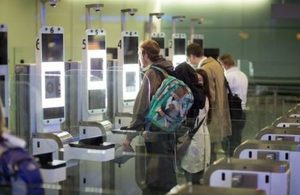 eGate hardware revenue will exceed $490 million by 2027; up from $207 million in 2023 according to a new report from Juniper Research.
eGate hardware revenue will exceed $490 million by 2027; up from $207 million in 2023 according to a new report from Juniper Research.
The report, with the catchy title Border Security Technologies: Emerging Trends, Key Opportunities & Market Forecasts 2022 2027, predicts that rising levels of international travel and greater passenger flow will drive the adoption of eGates, as a more efficient means of border control manual processes.
eGates, otherwise known as ABC (Automated Border Control) gates, allow users to verify their identity by comparing their biometric signature, usually captured by a facial recognition camera, with the information stored on the biometric chip of their passport.
The research predicts airports will be looking to implement efficient border control solutions to help manage increasing passenger flows, as international travel continues rebounding following the lifting of COVID-19-related travel restrictions.
Research author Jordan Rookes explained: “More international travel is placing an increased stress on border control operations, with many airports unable to effectively manage the complexities associated with heightened passenger flow. Accordingly, vendors must highlight their solutions’ ability to efficiently and reliably process a continuous flow of passengers when marketing their products.”
The research predicts that regulation, particularly within the EU, will drive adoption of eGates, with the value of eGate hardware revenue across Europe set to account for 35 per cent of the global total by 2027.
The EU has enacted regulations to improve the efficiency of border controls at the external borders of the Schengen area (the area in which 27 European countries have abolished border control measures across their mutual borders allowing free movement of people) by creating a centralised EES (Entry/Exit System) that useeGates.
This is available for use by non-EU nationals entering the EU. The research urges vendors to leverage advanced biometric and document capture technologies to meet the demands of border security, with success measured by efficiency, reliability and accuracy of passenger identification.





